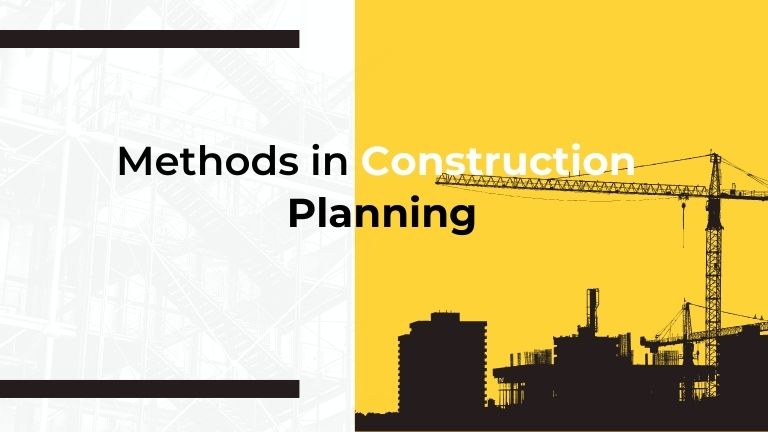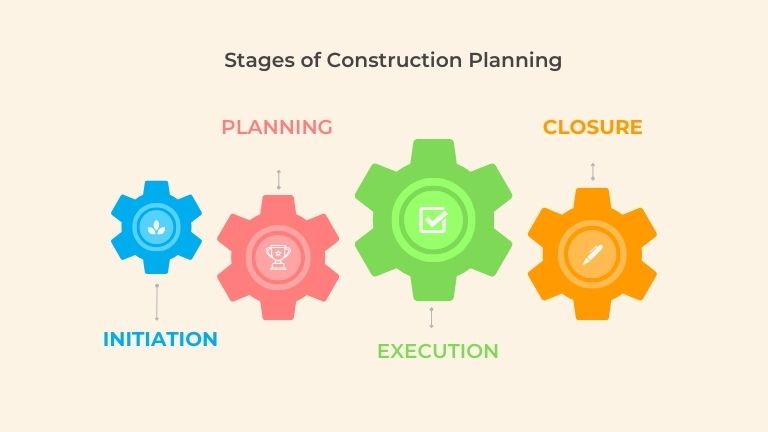Construction planning and scheduling are the real architects of the project’s success.
The construction industry is a never-ending niche around the globe that is foreseeing the future with captivating concerns in real-time.
One prominent factor that backs up the glory of the industry is construction planning and scheduling.
A proper plan and schedule for the construction workflow will eventually impact progress and avoid discrepancies and misconceptions about the project.
In this blog, we will cover the topics that help to understand the complete process of construction planning and scheduling.
- Importance of Construction Planning and Scheduling
- Methods of Construction Planning
- Creating a Construction Plan and Schedule
- 4 Stages of Construction Planning
- Construction Management Software
- Benefits of Construction Planning and Scheduling Software
- Enginero – One Stop Solution
Importance of Construction Planning and Scheduling
A process becomes streamlined when it is planned perfectly! This is the same for any industry, and so is the AEC industry.
Regardless of the genre, construction projects require extensive planning to establish a solid foundation. A proper plan can directly be effective on the project by determining factors like timeline, budget, and overall project efficiency.
Methods of Construction Planning and Scheduling

There are different methods of Construction Planning and every method has a distinct feature.
- Traditional Method
- Critical Path Method (CPM)
- Program Evaluation and Review Technique (PERT)
- Lean Construction
- Building Information Modeling (BIM)
- Integrated Project Delivery (IPD)
- Agile Construction
Traditional Method
The Traditional Method of construction follows sequential steps from project initiation to completion.
It involves well-defined steps from project conception, design development, procurement, construction, and project closeout.
This method follows linear project management techniques to ensure systematic progress.
Critical Path Method (CPM)
In Construction, the Critical Path Method (CPM) finds the most important tasks needed to finish the project. CPM Scheduling helps to schedule the tasks so that projects stay on track.
By focussing on the key tasks, CPM makes sure things get done on time and helps avoid delays.
Program Evaluation and Review Technique (PERT)
In Construction, PERT helps to find out how long the tasks might take by looking at the different possibilities.
It helps to identify the both best and worst outcomes for each task. This helps the project managers make smart choices and keep things on track.
Lean Construction
Lean Construction focuses on reducing waste and working together. This helps to make the building faster and cheaper.
It is about finding ways to do things smart and get rid of anything that slows down the process.
By Lean Construction’s ideas, we can finish the project quicker and save money.

Building Information Modeling (BIM)
Building Information Modeling (BIM) helps construction teams to make digital plans of buildings.
These plans show how everything fits together before the building starts. This helps to identify and reduce the mistakes at the early stage.
Using BIM, construction projects can be made easier and faster.
Integrated Project Delivery (IPD)
As the name suggests, this integrates all the construction team members early on to collaborate closely.
Architects, Builders, and other experts work as a single team to plan and execute the project efficiently.
The team will share the best and worst cases aiming for the best results together.
Agile Construction
In simple terms, Agile Construction is like being flexible and quick in building the project.
The process is breaking the bigger tasks into smaller ones and working closely together.
With a lot of communication and the ability to adapt fast, Agile construction makes building stuff easier and more successful.
Creating a Construction Plan and Schedule
Creating a construction plan involves various factors, like defining the scope of the project and including the key elements of the plan.
The plan has to be crafted to meet the guidelines that enhance proper collaboration opportunities among the stakeholders, including engineers, contractors, and architects
For the construction project, the prominence is shared equally for both planning and scheduling the workflow.
The detailed plan has to be shared with the teams, indicating and assigning the critical tasks to the exact team and informing them about their importance in the project. Scheduling must involve metrics to track the project’s progress.

4 Stages of Construction Planning and Scheduling
The four stages of Construction planning are,
- Initiation
- Planning
- Execution
- Closure
Initiation
In the initial stage of construction planning, ideas are brainstormed and checked for feasibility. In this stage, we figure out what we want to achieve, and how big the project will be. It also helps to identify how much the cost will incur.
It is like setting the stage for everything that comes next in the building process.
Planning
In the planning stage of construction, detailed plans are made for how the project will happen.
Here, the tasks are broken down, and the responsibility of who will do that will be decided. It is like making a roadmap to guide us through building something step by step.

Execution
In the execution stage of construction planning, the project plans are put into action. As the construction activity begins, the progress is closely monitored to ensure the tasks are completed according to the plan.
It is like turning our ideas and plans into a real structure.
Closure
In the closure stage of construction planning, the finishing of the project is done, and make sure everything is done right.
Final inspections are done here and make sure everything meets the standards and any remaining tasks are completed.
Construction Management Software
How about having software that makes the process of creating a construction plan and schedule with all the properties of excellence easier?
Such a solution is called construction management software, which extends assistance in enhancing complete management opportunities for the construction process.
The software makes it simple to monitor the project progression, daily report, team engagement, collaboration between teams, model coordination, and make sure to deliver the project in an appealing yet effective way.
That said, the construction management software enhances the construction planning and scheduling go-on-floor seamlessly and therefore carries out proper project progression.
The database in the software stores the model and keeps it intact with the properties of the project requirements. The features within the software streamline scheduling the construction plans for the respective teams and activate better team engagement and performance.
Benefits of Software for Construction Planning and Scheduling
Construction management software has vital benefits for construction planning and scheduling that streamline construction evolution and project engagement appropriately.
Seamless project management in Construction Planning and Scheduling
Since construction planning and scheduling are more important for project evolution, software for this can regulate seamless project management while meeting the guidelines of planning and scheduling.
The construction management software gives a centralized interface to create and assign project tasks to the teams and regulate the timeline for the project with the resources.
On a positive note, to improve project management, the software will optimize collaboration and communication among the teams and make sure everyone is on the same page about the construction project.
Cloud-Based Solution
The construction management software provides a centralized storage space for the project holders to store and track their project progress. The cloud solution ensures credibility for the project as the stakeholders and model coordinators can install their models with all the project documents.
The cloud-based software for construction planning and scheduling puts every project aspect under one single canopy, which makes it easy for the users to locate and carry out isolated tasks as per the requirements.
Accurate time management and tracking
The advantage of the construction management software is that it gives real-time tracking features to the users and lets them have control over the project’s evolution. For construction planning and scheduling, time management is important, and that is addressed with this software.
The software is transparent and makes it easy for the stakeholders to track the project’s progress. Moreover, the professionals with the software can detect clashes and issues with the models and rectify them faster, which saves ample time and effort.
Significant Collaboration in Construction Planning and Scheduling
A construction plan and its schedule are successful only when they are communicated to the respective resources. With the construction project, the teams are diverse and must be brought under one roof to enhance communication and collaboration.
Since the software is a comprehensive unit with all the members of the project, it makes it easy for them to collaborate on specific aspects of the project and work according to the construction plan and schedule.
BIM Integration
Building Information Modeling integration with construction management software is an added advantage to the aspect of construction planning and scheduling. BIM software applications enhance better ways of designing and implementing cohesive project management.
BIM models give exclusive visualization to the stakeholders and project participants, which helps in creating proper plans and scheduling specific sections or phases of the model for the respective teams.
Enginero: A one-stop solution for Construction Planning and Scheduling
We know that by this time you would have recognized the importance of construction planning and scheduling and the ability of one sole software to catalyze them.
Enginero can be the one exclusive software to propose an ideal construction management mechanism and deal with construction planning and scheduling.
Enginero is a significant construction management software with diverse features to stimulate exclusive management streams for the AEC industry.
The cloud-based software stores the model with all the documents and keeps it transparent to the teams so they can create a well-defined plan to execute.
Scheduling the workflow is made very simple with Enginero. Role management features in the software will let you assign roles and tasks to them and track the process’s workflow.
This transparent mechanism can determine the timeline of the task and render extensive assistance while scheduling pending tasks for the teams.
Conclusion
Construction planning and scheduling can be the most potent catalyst for the AEC industry to see massive strides in the future of construction projects. Creating a plan and informing the teams of the plans can impact the teams at a faster pace and bring their desires to reality.
Having one reliable construction management software is an advantage for this mechanism, and as we proposed about Enginero, this could be the right time to plunge in. Therefore, streamline construction planning and scheduling with more advanced aspects with Enginero.


Leave a Reply